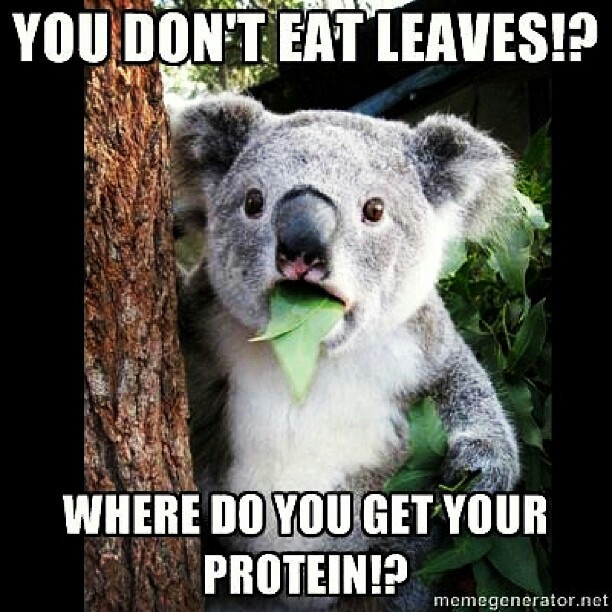
One of the most common things I hear as vegan is, “I would love to be vegan, but I’m worried that I wouldn’t get enough protein.”
I understand this concern; I had similar thoughts when I first changed my diet.
However, the majority of vegan foods are packed full of protein, and I find my protein intake is far higher being vegan than it was previously when I was vegetarian or a meat eater.
The Recommended Daily Allowance (RDA) for protein is 0.8 grams for every kilogram we weigh to meet our basic nutritional requirements. Not all proteins are digested the same, so to be on the safe side, 0.9 grams is often recommended. For vegans this amounts to approximately 10 percent of our calories coming from protein.
Protein is made up of amino acids, known as “building blocks,” as they break down into amino acids that promote cell growth and repair. They also help us feel fuller for longer on fewer calories, as they take longer to digest than carbohydrates.
Our human biological requirement is for amino acids, not protein, however we cannot make nine of the 20 amino acids required for good health. We need all nine of these amino acids for our body to make protein and these amino acids are considered essential.
Many people think that animal products, such as, meat, eggs, and dairy, are the best, and easiest, ways to get protein. However, they are usually high in saturated fat and cholesterol, therefore we may receive them from this type of food, but it doesn’t mean it is healthy for our body.
Research has shown that those eating a plant-based diet consume such a wide variety of amino acids that vegetarians and vegans can effortlessly get all of their amino acids if they balance their food intake well.
To ensure your diet has a good intake of protein, consider balancing your diet with any, or all, of the following.
Quinoa and other whole grains.
Quinoa, known as the “perfect protein,” is technically a seed and is higher in protein than most other whole grains. It is highly recommended for all, not just vegans and vegetarians, as it is high in magnesium, iron, fiber, and includes all nine of the essential amino acids the body needs for growth and repair, but cannot produce on its own.
Quinoa can be added to soup, served with strawberries as a hot porridge breakfast cereal, or mixed with vegetables. Click here for some simple quinoa recipes.
Oats are also among the healthiest grains and are loaded with vitamins and minerals including manganese, phosphorous, copper, iron, zinc, and vitamins B1 and B5.
Other whole grains, including whole-grain bread, brown rice, wheat bran, semolina, couscous, triticale, spelt, and barley are also good protein sources.
Nuts and seeds.
Nuts are loaded with healthy fats and proteins, making them a valuable part of a plant-based diet. However, they can be high in calories so it is worth considering nuts that are raw, or dry roasted, and ones that do not have a lot of added sugar and hydrogenated oils.
Peanuts, pistachios, hazelnuts, chestnuts, pecans, cashews, almonds, and walnuts are all good sources of protein.
Seeds including sesame, sunflower, flaxseed, hemp, and pumpkin are also amazing sources of protein.
Pumpkin seeds, in addition to protein, are excellent providers of iron and magnesium.
Hemp seeds are known as the “perfect protein” as they contain all 20 amino acids that the body needs. They can be added to smoothies, pestos, or baked goods, and hemp milk is way to add protein to your diet without consuming dairy.
Chia is often known as a “super seed” as they are high in essential minerals like calcium, phosphorus, magnesium, manganese, copper, zinc, iron, and niacin. They can be added to smoothies, sprinkled onto salads, stirred in yogurts and oatmeal, or consumed on their own. When marinated in liquid, they plump up and take on a gelatinous texture, forming a rich creamy pudding-like treat.
Beans, lentils, and chickpeas.
All beans, lentils, peas, and legumes are brilliant sources of protein.
Black beans are one of the healthiest beans as they are extremely high in protein and also one of the richest sources of antioxidants.
Chickpeas are a source of fiber, potassium, and protein and can be pureed to make hummus, added to salads, added to falafel dishes, or fried and salted to make a crispy snack.
Lentils are high in protein as well as other essential nutrients, which include iron, potassium, and folate. Gram for gram, they have more protein than beef.
Tempeh, tofu, and other soy products.
Food made from soybeans delivers some of the highest sources of protein.
Tempeh is made from cooked, fermented soybeans and formed into a patty, similar to a firm veggie burger. It is high in protein, easy to digest, and rich in probiotics.
Tofu can be added to almost anything, such as stir fries, pasta sauces, soup, and salad, and it can be soft or hard to offer a mash-like texture, or a texture as firm as meat. The harder the tofu, the higher the protein it contains. Firm tofu is not only high in protein and iron, but also provides approximately 22 percent of the daily recommended calcium intake.
Soy milk is a controversial topic for many; some people love it while others believe it is harmful. This is due to conflicting research, however many studies show that organic soy can prevent disease, and unsweetened soy that has not been highly processed is organic and free from GMOs and can actually be good for us.
The best part of soy is that it can be flavored with anything and when added to food it offers a creamy, chewy texture.
Other than soy milk there are many different ways of enjoying soy such as; edamame, soy ice cream, soy yogurt, soy nuts, or soy cheese.
Many brands of tofu and soy milk are fortified with other nutrients, such as calcium, iron, and vitamin B12.
Broccoli.
Broccoli contains eight of the essential amino acids and contains a high source of protein, and is a good source of calcium, potassium, manganese, vitamins A, B, C, and fiber.
A quick list of some of the most common protein sources:
Hemp, tempeh, soybeans, lentils, black beans, kidney beans, chickpeas, pinto beans, lima beans, black-eyed peas, veggie burgers, tofu, bagels, quinoa, peas, peanut butter, spaghetti, almonds, soy milk, whole wheat bread, almond butter, soy yogurt, bulgur, sunflower seeds, cashews, spinach, and broccoli.
I find it effortless to meet the protein recommendations on a vegan diet, as my diet consists of a mixture of vegetables, beans, grains, nuts, and seeds, which are all protein rich.
Consuming a healthy intake of protein, without consuming animal products, is as simple as having oatmeal for breakfast with fruit, adding seeds or nuts to a salad, beans to a pasta dish, sprinkling seeds on to pretty much any dish, or eating a handful of nuts as a snack.
If you have signs of protein deficiency, it is highly recommended to seek the advice of a medical professional.
~
~
~
Author: Alex Myles
Image: Memegenerator.net
Editor: Travis May
Copy Editor: Danielle Beutell
Social Editor: Sara Karpanen








Read 0 comments and reply